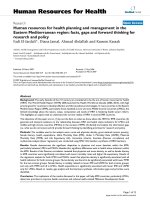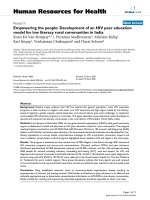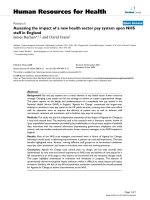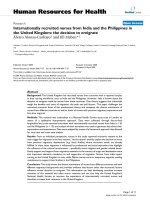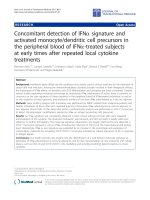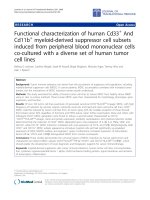Báo cáo sinh học: "At the crossroads: AMP-activated kinase and the LKB1 tumor suppressor link cell proliferation to metabolic regulation" pdf
Bạn đang xem bản rút gọn của tài liệu. Xem và tải ngay bản đầy đủ của tài liệu tại đây (114.71 KB, 4 trang )
Minireview
At the crossroads: AMP-activated kinase and the LKB1 tumor
suppressor link cell proliferation to metabolic regulation
John M Kyriakis
Address: Molecular Cardiology Research Institute, Tufts-New England Medical Center, 750 Washington Street, Boston, MA 02111, USA.
E-mail:
The AMP-activated protein kinase (AMPK) is a metabolic
master regulator that is activated in times of reduced energy
availability (high cellular AMP:ATP ratios) and serves to
inhibit anabolic processes [1-5]. In an AMP-dependent
manner, AMPK phosphorylates and inhibits acetyl-CoA car-
boxylase (ACC) [1,2], the rate-limiting enzyme in fatty-acid
synthesis; ACC catalyzes the formation of malonyl-CoA, a
potent inhibitor of fatty-acid oxidation. Accordingly, AMPK
acts to elevate fat oxidation and reduce lipogenesis [1,2].
AMPK also catalyzes the AMP-dependent phosphorylation
and inhibition of HMG-CoA reductase, the rate-limiting
enzyme in cholesterol biosynthesis, thus reducing cholesterol
formation [1,2,5]. In addition, AMPK activation suppresses
the expression of several lipogenic genes [2] and activates
phosphofructokinase-1, thereby suppressing glucose oxida-
tion and enhancing glycolysis (the Pasteur effect). AMPK is
activated in exercise, where it triggers glucose uptake by skele-
tal muscle in an insulin-independent manner, and phospho-
rylates and inhibits glycogen synthase [1-4].
In vivo, pharmacologic activation of AMPK with 5-aminoim-
idazole-4-carboxamide 1--D-ribofuranoside (AICAR) mimics
exercise and triggers insulin-independent glucose uptake by
skeletal muscle [2-4]. Thus, AMPK activators could alleviate
glucose intolerance; in support of this idea, the biguanide
drugs metformin and phenformin, as well as the thiazo-
lidinedione rosiglitazone, all of which have at one time
been used to treat type 2 diabetes (although phenformin is
now banned due to hepatotoxicity), may exert their effects
in part by activating AMPK [5-8]. In addition, mutations in
the ␥2 subunit of human AMPK have been linked to Wolff-
Parkinson-White syndrome (WPW), a condition marked by
cardiac hypertrophy and ventricular pre-excitation [9-11]
associated with the accumulation in the myocardium of
excess glycogen [10]. The WPW mutations in AMPK reduce
the kinase’s sensitivity to AMP and, accordingly, the extent
of its activation and overall activity in vivo and in vitro [11].
AMPK exists in the cell as a heterotrimer, the subunits of
which are widely conserved in evolution. The ␣ subunits
(␣1 and ␣2 in mammals) contain the protein kinase
domain and are homologous to the Saccharomyces cerevisiae
gene sucrose nonfermenting-1 (SNF1) [1]. The yeast Snf1p
protein and its associated subunits (see below) function to
enable cells to grow on sucrose or raffinose in the complete
absence of glucose. The functions of the  and ␥ subunits
Abstract
The tumor suppressor kinase LKB1 has been identified as a physiologic activator of the key
metabolic regulator 5-AMP-activated protein kinase, establishing a possible molecular link
between the regulation of metabolism and cell proliferation.
BioMed Central
Journal
of Biology
Journal of Biology 2003, 2:26
Published: 22 October 2003
Journal of Biology 2003, 2:26
The electronic version of this article is the complete one and can be
found online at />© 2003 BioMed Central Ltd
are still somewhat unclear, but all three subunits are neces-
sary for assembly of an active enzyme [1]. The mammalian
 subunits (1 and 2 in mammals) are homologous to
S. cerevisiae Sip1p, Sip2p and Gal83p and include amino-
terminal N-isoamylase domains that enable AMPK to bind
tightly to glycogen [12,13], a process that modestly inhibits
AMPK but may also enable glycogen synthase phosphoryla-
tion [1-4]. The AMPK ␥ subunits (␥1-␥3 in mammals) are
homologous to S. cerevisiae Snf4p and each contains four
cystathionine--synthase (CBS) domains [1]. Inasmuch as
the ␥-subunit mutations of WPW reduce AMPK’s sensitivity
to AMP [11], it is thought that the ␥ subunits contain the
AMP-binding site. The reduced AMP sensitivity in WPW, by
reducing AMPK-mediated inhibition of glycogen synthase,
might account for the glycogen storage disorder associated
with the disease.
Although AMP was originally identified as an allosteric acti-
vator of AMPK, the regulation of AMPK by AMP is complex.
Thus, AMP also inhibits dephosphorylation and deactiva-
tion of the kinase, and AMP potentiates phosphorylation
and activation of AMPK by an upstream kinase AMPK-
kinase (AMPKK; Figure 1) [1]. The existence of an AMPKK
was suggested by the observation that AMPK could be deac-
tivated by protein phosphatases. An AMPKK was partially
purified by several laboratories, and these preparations
could phosphorylate the AMPK ␣ subunit at Thr172 in the
kinase activation loop [1,14,15]; this phosphorylation is
required for optimal AMPK activity [14,15]. Interestingly,
partially purified AMPKK appeared itself to rely on AMP for
efficient activation of AMPK; it was proposed either that
AMPKK, like AMPK itself, was allosterically regulated by
AMP or that binding of AMP to AMPK made AMPK a better
AMPKK substrate [14,15]. More recent work has shown that
AMPKK activity can be resolved chromatographically into
two peaks (AMPKK1 and AMPKK2) [14,16]. But despite
heroic efforts, the mammalian AMPKK(s) have been resis-
tant to traditional methods of protein purification and
sequencing - until now [16].
Studies of the regulation of yeast Snf1p paved the way to the
identification of a mammalian AMPKK complex. Snf1p, the
S. cerevisiae ortholog of the AMPK ␣ subunit, is like its mam-
malian counterpart in requiring phosphorylation for activity;
Thr210 is the site in the Snf1p activation loop analogous to
Thr172 of mammalian AMPK ␣ [1]. A small family of yeast
protein kinases, known as polymerase alpha kinase-1
(Pak1p), not to be confused with mammalian p21-activated
kinase-1, also abbreviated Pak1), Tos3p and Elm1p, were
recently identified as Snf1p kinases [17-19]. Thus, mass-
spectrometric analysis of proteins associated with the Snf1p
complex identified Pak1p and Tos3p as Snf4p interactors
[17,18]; Pak1p can also bind Snf1p [17]. This association of
Pak1p with Snf1p is enhanced under the low glucose condi-
tions in which Snf1p is activated [17]. Pak1p, Tos3p and
Elm1p can all phosphorylate Snf1p at Thr210 [17-19]
(indeed, Elm1p was selected in a proteomic screen for
Snf1p Thr210 kinases [19]); but neither single nor double
mutant strains carrying deletions of pak, tos3, or elm1, dis-
plays a Snf
-
phenotype (inability to grow on sucrose in the
absence of glucose) [17-19]. Only a triple pak1-tos3-elm1
deletion mutant showed a Snf
-
phenotype [18,19], suggest-
ing a high degree of functional redundancy among the yeast
Snf1p kinases.
Interrogation of mammalian genomic databases indicates
that the Pak1p/ Tos3p/ Elm1p family is most closely related
26.2 Journal of Biology 2003, Volume 2, Issue 4, Article 26 Kyriakis />Journal of Biology 2003, 2:26
Figure 1
Regulation of AMPK. AMPK (blue) becomes activated under conditions
of high AMP/ATP (metabolic depletion), or in response to the
hormones leptin and adiponectin [1,25,26]. Under these circumstances,
AMP binds to AMPK, facilitating phosphorylation at Thr172 and
activation, in a reaction catalyzed by the LKB1-STRAD-MO25 complex
(AMPKK; red). AMP also prevents dephosphorylation and deactivation
of AMPK and serves as an allosteric activator of AMPK. See text for
further details.
α
β
γ
AMP
Thr172
α
β
γ
AMP
α
β
γ
α
β
γ
AMP
Low AMP/ATP High AMP/ATP or
leptin or adiponectin
Inactive
Maximally
active
LKB1
STRAD
AMPK
AMPKK
MO25
Protein
phosphatase
P
Thr172
P
to mammalian calcium-calmodulin kinase-kinases (CaMKKs)
and to the tumor suppressor kinase LKB1. But although
CaMKK can weakly phosphorylate the AMPK ␣ subunit at
Thr172, partially purified mammalian AMPKKs - unlike
CaMKKs - are not dependent on Ca
2+
and calmodulin [20],
making it unlikely that CaMKKs are physiologically relevant
AMPKKs. By contrast, Hong et al. [18] showed that, in vitro,
LKB1 could phosphorylate the mammalian AMPK ␣ subunit
at Thr172; but it was unclear from this finding that LKB1
was, in fact, a physiologically relevant AMPKK. Hawley et al.
[16] now present dramatic and convincing evidence that
LKB1 is a major, physiologically relevant mammalian
AMPKK. The regulatory relationship between LKB1 and
AMPK provides a concrete link between the control of cell
proliferation and nutrient regulation of cell metabolism.
The lkb1 gene encodes a serine/threonine kinase that is
mutated in Peutz-Jeghers syndrome (PJS), an autosomal-
dominant tumor-predisposition disorder that is character-
ized most notably by the development of hamartomatous
polyps in the gastrointestinal tract [21]; PJS patients are espe-
cially at increased risk for the development of malignant
tumors of the gastrointestinal tract. PJS arises from loss-of-
function mutations (primarily in the kinase domain) in
LKB1 and although PJS is dominantly inherited, it is not
clear if tumor formation is due to haploinsufficiency or to
loss of heterozygosity [21].
LKB1 is regulated by interactions with two adaptor proteins.
Ste20-related adaptor (STRAD, with ␣ and  isoforms in
mammals) is a polypeptide of 45-48 kDa that is related to
the Ste20 family of protein kinases. STRAD is a pseudo-
kinase, however, as it lacks key residues (notably in the con-
served phosphotransferase region) required for catalyzing
protein phosphorylation. The binding of STRAD to LKB1
substantially activates LKB1’s autophosphorylating kinase
activity and its ability to phosphorylate myelin basic
protein. STRAD binding also targets LKB1 to the cytosol
[22]. Mouse protein 25 (MO25, again in ␣ and  forms) is a
second adaptor protein of 40 kDa that regulates LKB1.
MO25 binds STRAD and functions to stabilize the STRAD-
LKB1 complex [23].
Hawley et al. [16] show that all three components of the
LKB1 complex - LKB1, STRAD␣ and MO25␣ - coelute pre-
cisely on anion exchange columns with both rat liver
AMPKK peaks. The LKB1 immunoreactivity in the AMPKK1
peak runs faster on SDS polyacrylamide gels than that of
AMPKK2; and this is not due to reduced phosphorylation,
because phosphatase treatment fails to enhance the mobility
of the LKB1 immunoreactivity in the AMPKK2 peak [16]. It
is not known if this difference in gel mobility accounts for
the resolution of AMPKK1 and AMPKK2 as separate peaks
upon ion-exchange chromatography. Immunoprecipitation
of LKB1 can almost completely deplete either AMPKK peak
of AMPK-activating activity; and recombinant LKB1-
STRAD␣-MO25␣ purified from transfected cells also phos-
phorylates the AMPK ␣ subunit on Thr172. LKB1 expressed
alone is incapable of phosphorylating the AMPK ␣ subunit,
however, indicating a requirement for the STRAD and MO25
subunits [16]. By comparison with a STRAD␣ and MO25␣
complex, LKB1 in a complex with STRAD and MO25 is a
poor AMPKK [16]. Of note, the LKB1-STRAD-MO25
complex can phosphorylate both isolated, bacterially
expressed AMPK ␣ subunit, and the ␣ subunit as part of an
intact AMPK heterotrimer [16].
As noted above, AMP has been shown to enhance phospho-
rylation of AMPK by AMPKK (Figure 1) [14,15,20]. Addi-
tion of AMP enhances phosphorylation of intact AMPK
heterotrimers by LKB1-STRAD-MO25 heterotrimers, but
fails to enhance phosphorylation of the isolated, bacterially
expressed AMPK ␣ subunit by LKB1-STRAD-MO25 [16].
This result suggests that AMP does not directly activate the
LKB1 complex, but that binding of AMP to the AMPK
complex renders AMPK a better LKB1-STRAD-MO25 sub-
strate [16]. It will be important to confirm this finding with
intact AMPK heterotrimers harboring mutations in the
AMP-binding site - once this site has been precisely
mapped. The regulation by AMP of the phosphorylation of
AMPK by LKB1-STRAD-MO25 is somewhat similar to the
indirect regulation by inositol lipids of the activation of
protein kinase-B (PKB)/Akt by 3-phosphoinositide-
dependent kinase-1 (PDK1) [24].
Hawley et al. [16] provide genetic evidence that attests to the
physiologic relevance of LKB1 to AMPK regulation. Thus,
HeLa cells do not naturally express LKB1; in these cells, the
drugs AICAR and phenformin fail to activate AMPK, and
transient transfection of LKB1 restores this activation [16].
Disruption of murine lkb1 produces embryonic lethality; but
lkb1
-/-
mouse embryonic fibroblasts (MEFs) have been gener-
ated. In contrast to lkb1
+/+
MEFs, in which AICAR and phen-
formin readily activate AMPK, the AMPK in lkb1
-/-
MEFs is
not activated by either treatment [16]. Thus, LKB1 is both
necessary and sufficient for activation of AMPK.
These mammalian cell, biochemical and genetic data
present an interesting contrast with the situation in yeast, in
which three Snf1p kinases have been identified [17-19].
While it is certainly possible that additional AMPKKs will be
identified in cell types other than HeLa or MEFs, the paucity
of LKB-like kinases in the human genome argues against this
idea. This difference between yeast and mammalian cells
may reflect the more extreme metabolic demands faced by
unicellular eukaryotes, as compared with mammalian cells,
Journal of Biology 2003, Volume 2, Issue 4, Article 26 Kyriakis 26.3
Journal of Biology 2003, 2:26
which have numerous methods for storing and distributing
metabolites. Alternatively, LKB1 may interact with regula-
tory proteins other than STRAD and MO25, allowing for a
measure of heterogeneous regulation and/or functional
redundancy. With this in mind, the prominence of
endocrine versus metabolite control of AMPK and the func-
tion of LKB in these processes are important areas of investi-
gation. For example, leptin and adiponectin, hormones
produced by adipocytes, stimulate fatty acid oxidation and
glucose utilization via activation of AMPK [25,26]. It will be
important to determine whether LKB1 - in complex with
STRAD and MO25 isoform(s) - mediates the actions of
leptin and adiponectin.
The link between LKB1 and PJS, and the identification of
LKB1 as a tumor suppressor and now as the long-sought
AMPKK, provide a molecular basis for the interaction
between metabolism and cell proliferation. It is possible that
AMPK-activating drugs could prove promising in the treat-
ment of LKB1-deficient cancers. Furthermore LKB1 now joins
AMPK as an attractive target for activating drugs that would
be useful in the treatment of obesity and type 2 diabetes.
References
1. Hardie DG, Carling D, Carlson M: The AMP-activated/SNF1
protein kinase subfamily: metabolic sensors of the eukary-
otic cell? Annu Rev Biochem 1998, 67:821-855.
2. Winder WW, Hardie DG: The AMP-activated protein
kinase, a metabolic master switch: possible roles in type 2
diabetes. Am J Physiol 1999, 277:E1-E10.
3. Goodyear LJ: AMP-activated protein kinase: a critical sig-
naling intermediary for exercise-stimulated glucose
uptake? Exerc Sport Sci Rev 2000, 28:113-116.
4. Mu J, Brozinick JT, Vallardes O, Bucan M, Birnbaum MA: A role
for AMP-activated protein kinase in contraction and
hypoxia-regulated glucose transport in skeletal muscle.
Mol Cell 2001, 7:1085-1094.
5. Moller DE: New drug targets for type 2 diabetes and the
metabolic syndrome. Nature 2001, 414:821-827.
6. Zhou G, Myers R, Li Y, Chen Y, Shen X, Fenyk-Melody J, Wu M,
Ventre J, Doebber T, Fujii N, et al.: Role of AMP-activated
protein kinase in mechanism of metformin action. J Clin
Invest 2001, 108:1167-1179.
7. Fryer LG, Parbu-Patel A, Carling D. The anti-diabetic drugs
rosiglitazone and metformin stimulate AMP-activated
protein kinase through distinct signaling pathways. J Biol
Chem 2002, 277:25226-25232.
8. Hawley SA, Gadalla AE, Olsen GS, Hardie DG: The antidiabetic
drug metformin activates the AMP-activated protein
kinase cascade via an adenine nucleotide-independent
mechanism. Diabetes 2002, 51:2420-2425.
9. Blair E, Redwood C, Ashrafian H, Oliveira M, Broxholme J, Kerr B,
Salmon A, Ostman-Smith I, Watkins H: Mutations in the
␥␥
(2)
subunit of AMP-activated protein kinase cause familial
hypertrophic cardiomyopathy: evidence for the central
role of energy compromise in disease pathogenesis. Hum
Mol Genet 2001, 10:1215-1220.
10. Arad M, Benson DW, Perez-Atayde AR, McKenna WJ, Sparks EA,
Kanter RJ, McGarry K, Seidman JG, Seidman CE: Constitutively
active AMP kinase mutations cause glycogen storage
disease mimicking hypertrophic cardiomyopathy. J Clin
Invest 2002, 109:357-362.
11. Daniel T, Carling D: Functional analysis of mutations in the
␥␥
2 subunit of AMP-activated protein kinase associated with
cardiac hypertrophy and Wolff-Parkinson-White syn-
drome. J Biol Chem 2002, 277:51017-51024.
12. Hudson ER, Pan DA, James J, Lucocq JM, Hawley SA, Green KA,
Baba O, Terashima T, Hardie DG: A novel domain in AMP-
activated protein kinase causes glycogen storage bodies
similar to those seen in heredetary cardiac arrythmias.
Curr Biol 2003, 13:861-866.
13. Polekhina G, Gupta A, Michell BJ, van Denderen B, Murthy S, Feil
SC, Jennings IG, Campbell DJ, Witters LA, Parker MW, et al.:
AMPK

subunit targets metabolic stress sensing to glyco-
gen. Curr Biol 2003, 13:867-871.
14. Hawley SA, Davison M, Woods A, Davies SP, Beri RK, Carling D,
Hardie DG: Characterization of the AMP-activated protein
kinase kinase from rat liver, and identification of threo-
nine-172 as the major site at which it phosphorylates and
activates AMP-activated protein kinase. J Biol Chem 1996,
271:27879-27887.
15. Stein SC, Woods A, Jones NA, Davison MD, Carling D: The reg-
ulation of AMP-activated protein kinase by phosphoryla-
tion. Biochem J 2000, 345:437-443.
16. Hawley SA, Boudeau J, Reid JL, Mustard KJ, Udd L, Mäkelä TP,
Alessi DR, Hardie DG: Complexes between the LKB1
tumour suppressor, STRAD
␣␣
/

and MO25
␣␣
/

are
upstream kinases in the AMP-activated protein kinase
cascade. J Biol 2003, 2:28.
17. Nath N, McCartney RR, Schmidt MC: Yeast Pak1 kinase associ-
ates with and activates Snf1. Mol Cell Biol 2003, 23:3909-3917.
18. Hong S-P, Leiper FC, Woods A, Carling D, Carlson M: Activa-
tion of yeast Snf1 and mammalian AMP-activated protein
kinase by upstream kinases. Proc Natl Acad Sci USA 2003,
100:8839-8843.
19. Sutherland CM, Hawley SA, McCartney RR, Leech A, Stark MJR,
Schmidt MC, Hardie DG: Elm1p is one of three upstream
kinases for the Saccharomyces cerevisiae SNF1 complex.
Curr Biol 2003, 13:1299-1305.
20. Hawley SA, Selbert MA, Goldstein EG, Edelman AM, Carling D,
Hardie DG: 5
-AMP activates the AMP-activated protein
kinase cascade and Ca
2+
/calmodulin the calmodulin-
dependent protein kinase I cascade, via three independent
mechanisms. J Biol Chem 1995, 270:27186-27191.
21. Boudeau J, Sapkota G, Alessi DR: LKB1, a protein kinase reg-
ulating cell proliferation and polarity. FEBS Lett 2003,
546:159-165.
22. Baas AF, Boudeau J, Sapkota GP, Smit L, Medema R, Morrice NA,
Alessi DR, Clevers HC: Activation of the tumour suppressor
kinase LKB1 by the STE20-like pseudokinase STRAD.
EMBO J 2003, 22:3062-3072.
23. Boudeau J, Baas AF, Deak M, Morrice NA, Kieloch A, Schutowski
M, Prescott AR, Clevers HC, Alessi DR: MO25
␣␣
/

interact with
STRAD
␣␣
/

enhancing their ability to bind, activate and
localize LKB1 in the cytoplasm. EMBO J 2003, 22:5102-5114.
24. Alessi DR, James SR, Downes CP, Holmes AB, Gaffney PRJ, Reese
CB, Cohen P: Characterization of a 3-phosphoinositide-
dependent protein kinase which phosphorylates and acti-
vates protein kinase B
␣␣
. Curr Biol 1997, 7:261-269.
25. Minokoshi Y, Kim YB, Peroni OD, Fryer LG, Muller C, Carling D,
Kahn BB: Leptin stimulates fatty-acid oxidation by activat-
ing AMP-activated protein kinase. Nature 2002, 415:339-343.
26. Yamauchi T, Kamon J, Minokoshi Y, Ito Y, Waki H, Uchida S,
Yamashita S, Noda M, Kita S, Ueki K, et al.: Adiponectin stimu-
lates glucose utilization and fatty-acid oxidation by acti-
vating AMP-activated protein kinase. Nat Med 2002,
8:1288-1295.
26.4 Journal of Biology 2003, Volume 2, Issue 4, Article 26 Kyriakis />Journal of Biology 2003, 2:26


